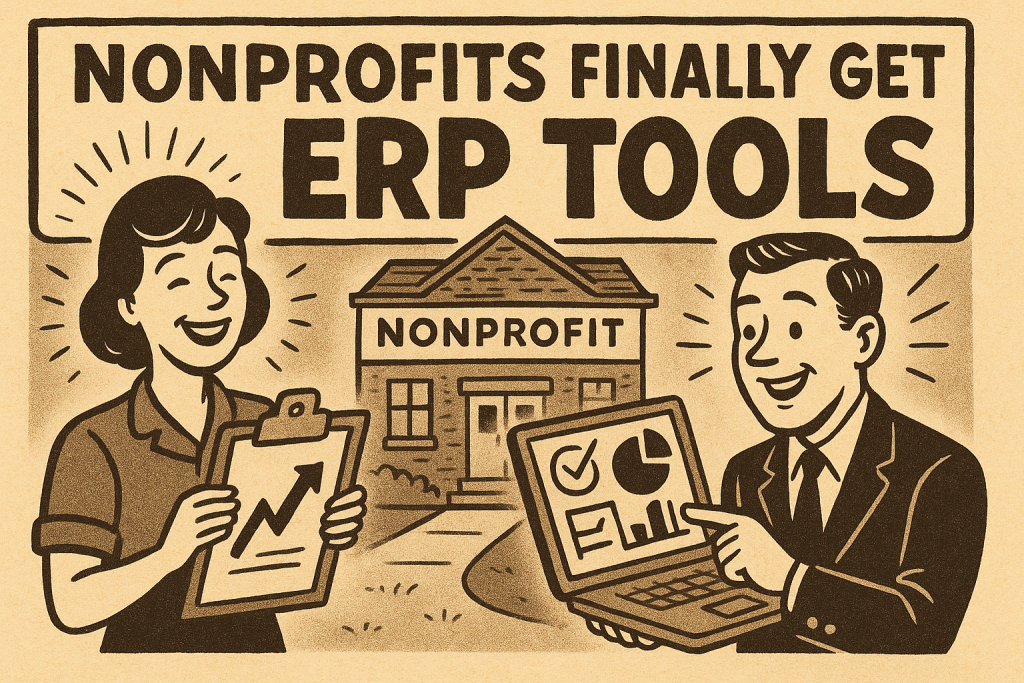
Why Nonprofits Are Missing Out on the ERP Advantage—And How That’s Finally Changing
For decades, Enterprise Resource Planning (ERP) systems have been a cornerstone of operational efficiency in the corporate world. From finance and procurement to HR and logistics, these systems help businesses automate, integrate, and manage their core processes in a single platform. But while for-profit companies have leveraged ERP to streamline operations and scale with confidence, nonprofit organizations have largely been left behind.
The reason isn’t a lack of need. In fact, nonprofits often manage incredibly complex workflows—grant reporting, donor engagement, volunteer coordination, compliance, fundraising campaigns, and service delivery—often with more moving parts and regulatory oversight than many businesses.
The problem is that traditional ERP systems have been out of reach for most nonprofits. And that’s a real loss.
The Barriers: Cost and Capacity
Ask any nonprofit director about the barriers to adopting ERP, and you’ll likely hear two words:
– Cost
– Capacity
- High Licensing and Implementation Costs
Traditional ERP systems often come with steep upfront fees, recurring licensing costs, and expensive implementation consultants. Even with nonprofit discounts, these costs are hard to justify for organizations running on tight budgets.
- Limited Internal Bandwidth
Implementing an ERP system requires dedicated internal time—mapping processes, overseeing data migration, training users, and managing change. For nonprofits with small teams and overburdened staff, that’s simply not feasible.
- Systems Built for Business, Not Mission
Most ERP solutions are built for the needs of large enterprises, not mission-driven organizations. Customizing them to fit the specific reporting, compliance, and relationship needs of a nonprofit can be more trouble than it’s worth.
As a result, many nonprofits rely on fragmented tools—spreadsheets, disconnected databases, and cobbled-together CRMs—leaving them with data silos, inefficiencies, and limited visibility into their operations.
What They’re Missing
By not implementing a robust, unified system, nonprofits are missing out on:
- Better donor and grant tracking
- Automated reporting for audits, funders, and boards
- Real-time insights into program performance and resource allocation
- Streamlined volunteer management and event planning
- More time for mission, less time lost to admin
ERP systems can provide exactly these benefits—but only if they’re accessible.
The Turning Point: Open-Source and No-Code ERP Tools
The good news? That’s starting to change.
A new wave of open-source, no-code ERP platforms is making it possible for nonprofits to implement custom, mission-aligned systems without breaking the bank or burning out their teams.
Here’s what’s different:
- No licensing fees — Open-source models eliminate recurring software costs.
- Customizable without developers — No-code tools let staff build exactly what they need through intuitive interfaces.
- Faster setup — Pre-built modules and drag-and-drop logic reduce implementation time from months to weeks.
- Flexible and future-proof — Systems can evolve as your organization grows or shifts focus.
Instead of adapting their mission to fit rigid software, nonprofits can now build software that fits their mission—on their own terms.
A New Chapter for Nonprofit Tech
We’re entering a new era where nonprofits no longer have to settle for outdated systems or off-the-shelf tools that don’t serve their needs.
With open-source, no-code ERP tools now in reach, nonprofits can:
- Operate more efficiently
- Prove their impact with better data
- Scale without scaling their administrative burden
- Spend more time on mission, and less time on manual processes
It’s not just a tech upgrade. It’s a shift in power—from costly vendors to capable teams. And it couldn’t come at a better time.
